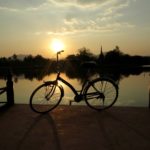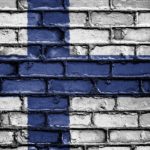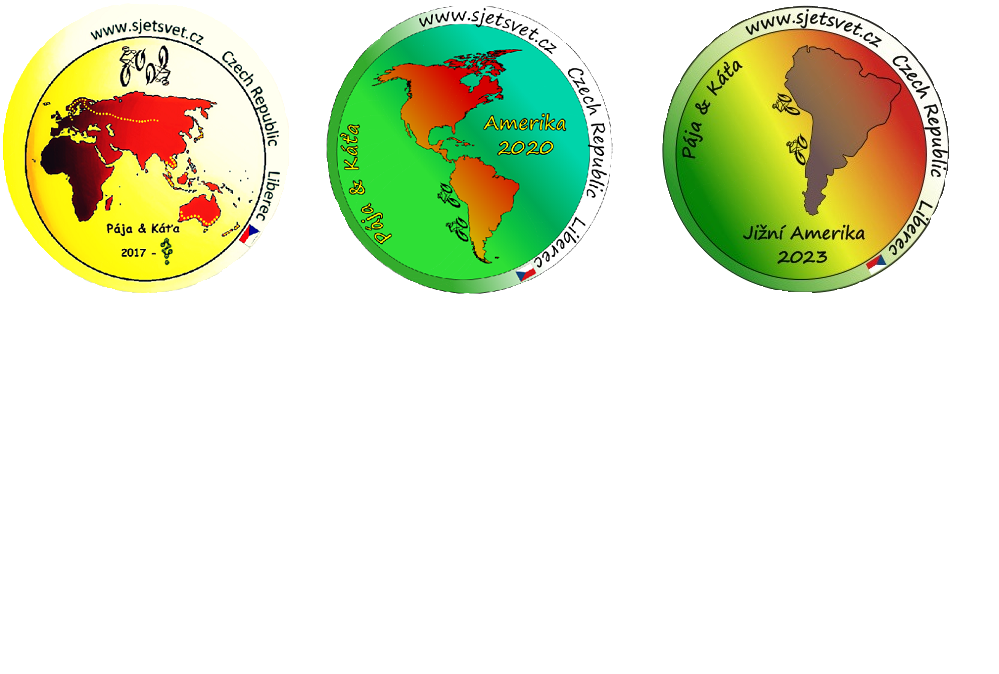Norway 4
27. 7. 2017 - 19. 8. 2017, Trondheim - finnish border 1797,5 km
The way from Trondheim wasn’t as easy as we expected. We planned to go on the arctic highway no. E6 but it was not possible to attach to it right from the beginning so we had to use the cycle paths. Due to this we did some kilometers extra plus the landscape along wasn’t too interesting. The only advantage was that they leaded us to the town Stiklestad in which The St. Olav festival was happening. Stiklestad was the place where the famous Viking Olav Haraldsson died in the battle with peasants and local kings. The battle by Stiklestad meant an important mile stone in the Norwegian history because since then the
Christianity started to be spread. Trondheim and Stiklestad became pilgrimage places. In the time of our visit there was a little Viking town replicated but the entry was so expensive that we voluntarily skipped this attraction. We rather visited the church which was supposedly built exactly on the spot where Olav was killed. The detailed description of the church was available in 16 languages and to our surprise one of them was even Czech. After this culture experience we continued further in between the fields and we connected to the road E6. Many bikers use this road up to Nordkapp. We evaluate this way as totally
terrible. We were just waiting by every moment that some car caught our side packs on our bikes and we ended up in a drain. Psychically exhausted we arrived to the closest camp, got some info material and were thinking where to go next. We had two options. Either to continue on the arctic high way which is leaded by waterfalls and we would have a chance to take a picture b the symbol of the Arctic Circle or to go along the coast road no. 17 which is rated as one of the 100 most beautiful roads in the world but you need to take a ferry 6-
times. Eventually we chose the safer but also more expensive way, the road no. 17 (Kystriksveien) and we hopes it won’t be too wind as it’s too close to the sea.
From the first moment it was clear that this road is very popular among bikers. We met a lot of them, even a few solo-biking girls. During one of our break we met a Norwegian couple and we started to chat with them. After the first question- where do we come from- they didn’t look confused as most of the other people whom we have met so far. On the contrary, they shined. They have visited our home country 3 times already and they really liked it. The woman was wondering why we came to Norway if we had such a beautiful country. And her husband? He was wearing a cycle training suit with Svijany logo on it. He
said this one is his most favorite. The cost road was flowing fast. More or less it was all flat and it was windless luckily. Besides the amazing sea with many tiny little islands we passed around the signs warning against the presence of moose. However we were passing those signs since Sweden and didn’t spot any so we had lost the hope to see one long ago. When all of the sudden one car which was coming in an opposite direction towards us stopped on the road and stayed on one spot for a while. We didn’t know what was going on but we
slowed down and started to look around if something was about to happen. In the next moment it was clear to us. A huge grey brown moose’ butt on tall slim legs was showing up from a bush. When spot us she showed us herself in her full beauty and then she left. We didn’t even have time to take a picture of her. We knew it was a female moose because she didn’t have any antlers. Kata found the hope again that maybe we saw more of them and we managed to take a photo. And we did. Paja saddled one actually. It took her like 10 minutes and one injury but she was happy like a little girl.
We read somewhere that on this road there can be long distances between shops so it’s better to buy food or other stuff for two days ahead. We underrated this advice and one day we had to go for 60 km without any food until we passed the first shop. If it could have been even called “a shop”. The bread so crunchy that rabbits could sharp its teeth on it, many products with overdue best before date and not a trace of our favorite goods. So we chose the cheapest versions of the eatable food. What a change for our stomachs. Nicely
full we arrived to the ferry port and we came to the Arctic Circle. We took a picture of its symbol. Paradoxically it is not cold behind the Arctic Circle. On contrary we were experiencing the hottest days in Norway. There were even white sand beaches so we felt like at Caribbean Sea. We camped on the beach twice. On the bright sunny day we were getting closer to the big town Bodo by which the Kystriksveien ends. Shortly before arrival to this town we were able to see another natural phenomena – the strongest water stream in the world – Saltstraumen. It’s so strong that during the tide comes it’s restricted for ships
to float around. We saw it during the tide go and even though it was breathtaking.
From Bodo we shipped over to Kata’s highly expected Lofoten. The cruise took 4 hours and during this time the weather changed rapidly. When we arrived to Moskenes the sky was pretty dark so we quickly changed our summer clothes for long sleeves. Tropics were gone. The Lofoten islands are famous for drying the fish. In winter codfish come here and in the same time period there are perfect conditions for drying them (due to combination of temperature, humidity and wind). All the islands are connected with bridges. Roads are
very narrow therefore there are traffic lights at the beginning of each bridge because you can drive only in one direction. Shortly after leaving Moskenes we smelled the fish aroma. We went through the first fish village. There were the wooden construction for drying everywhere but empty at this time of the year. On the other hand stores were full of dried fish of all different kinds. Paja wanted to buy a one meter long codfish with an open mouth but Kata dissuaded her from it. So at least we got a little pack of fish meat for tasting. And it was delicious. Camping on Lofoten was very difficult. We hardly found a good place to build a tent and there was also very little water in the nature. It took us three days to go all over the islands and then we sailed to a neighbor islands – Vestralen.
The landscape was not so lovely anymore. Little trees, moss and bilberries. Up on the north by the city Andenes the nature looked better. We had the chance to relax on the white beaches while listening to a terrible gulls’ screaming. Vestralen are mostly visited for the whales seeing. This experience is offered by many agencies but the prices are really high. So we built our tent by the sea and Kata decided to watch for them. After an hour the water churned up like 100 m from us. While Paja was running as far away to the sea as rocks allowed, Kata was looking for her glasses in her backpack. It were really whales and even that they were far away we saw a couple of fins. It was a very pleasant farewell with
Vestralen.
The very next day we were sailing to the Senja Island around which there would be a perfect ride on a sea kayak. The sea had all the blue colors and the islands were as big as for one tent exactly. The Island has its own rarity – a giant troll with troll wife and troll children. They are the largest trolls in the world and in 1997 they were written into Guinness world records book. To us this curiosity seemed a bit tasteless. From this beautiful island it was only a short distance to the earth which we recognized according to growing amount of hills and fresh water. We cycled through the Troms which was a little bit different from other parts. For instance it has its own app for transport purchase, including
ferries with 30% discount from price. On some of the ferries you need to pay only for motor vans. The transport of persons is for free. By every tunnel there are boxes with reflex vests for bikers for free and there are also emergency buttons for bikers inside of the
tunnels.
In the city Tromso a biking race took place. We didn’t really get its organization and we didn’t even find the start, nor the end. Due to the race there was a limited access in the city so we didn’t spend too much time there. We saw only the arctic cathedral. Further to north there is the only road, the E6. After our first experience with this road we were doubtful but fortunately the traffic wasn’t that bed. Despite the bad weather we were cycling quickly and we even picked up some mushrooms on the way. After having a mushroom sauce for the
second time we decided to leave all the other mushrooms to someone else.
The more to north the emptier the landscape was. But there was still enough hills.
By one of them we spotted a traditional house of Sami people – lavuu (a cone tent
covered with leather). Two grannies in traditional dresses suddenly came out from the tent and both ran to their stands with handmade articles made mostly out of reindeer antlers and leather. Sadly we didn’t have any cash so we just appreciated the beautiful stuff and took a picture with the grannies. Signs along the way warning from moose changed with signs warning from reindeers. We didn’t hope we could have spot them. However as often as sheep are crossing over the roads on the south of Norway the same is the situation on the north with reindeers. They are beautiful animals with huge antlers. In the city called Alta we finished our direction leading to north and for the first time on our way since we left home we went to the south to the Finish border.
What did we like about Norway?
K – an amazing nature; the state’s interest in residents and also tourists; safety; the possibility to camp anywhere legally; coffee in thermos and mooses
P – a clean nature; drinkable water available everywhere; First Price; friendly and
tolerant Norwegians; long day light
What did we don’t like about Norway?
both – annoying Midge’s flies; very expensive local transportation (ferry, bus)

























































 Previous Post
Previous Post Next Post
Next Post